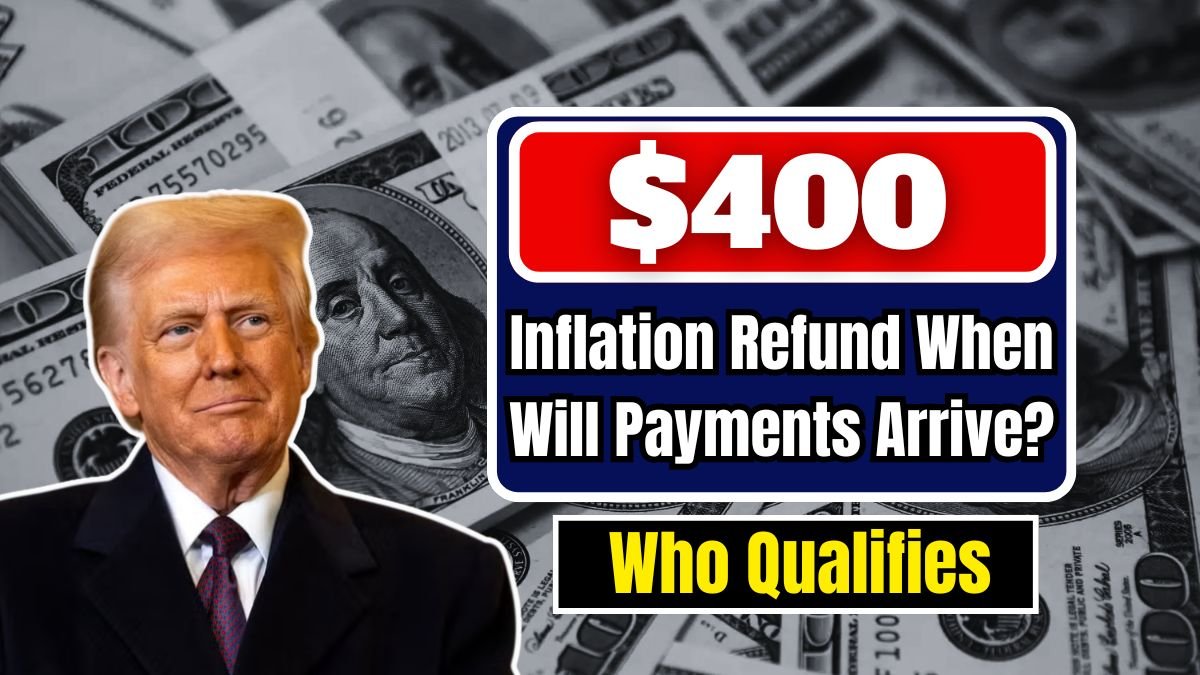The now-average American will be experiencing grave constraints by the year 2024-25. With inflation, rents have skyrocketed, and food prices broke past heights, while fluctuations in gas prices and medical bills were the final straw for so many American families. Wherefore, several plans and programs tried to protect the citizens, created both by the state and federal governments. One such program for the year 2025 is the $400 Inflation Refund, otherwise commonly called the Inflation Relief Amount.
This helps people and families unable to make ends meet because of inflation. Therefore, this 2025 $400 refund would serve in realizing relief for persons already limping along and would show that the government wants to share this burden with its citizens.
In this article, we will showcase what the $400 Inflation Refund 2025 Program is for, who will be eligible, what this program seeks to achieve, when payments are supposed to be made, and what one should do to lay claim to this cash.
So What Is This $400 Inflation Refund 2025?
The $400 Inflation Refund is financial assistance paid to an individual in 2025 that meets the requirements for eligibility. The amounts generally termed refunds or grants are relief payments to citizens for damages inflicted upon them by inflation. The states administer this program separately, so eligibility and other regulations might vary just a bit by state; in most general sense, the economic well-being in an increasingly expensive environment, remains the rationale behind this support.
Indeed, the payment is also, at least, a kind of benefit in the essence that the beneficiary shall not bear any tax liability in respect of any amount so received. The government could send the money straight to the bank account of the beneficiary by means payable at the counter or send it by traditional cheque-cum-postal services in case of the recipient’s needs.
[also_read id=”3134″]
What Prompted the Issuing of the $400 Inflation Refund by the Government?
For about the last two years in America, inflation had more or less become the norm such that subsets of society, but more concerningly, households having lower and median incomes were left with permanent marks as a result of its upward movement. Grocery prices, rents, medicines, transportation were ones that these household activities declared were staring at their faces, bordering at times on the exaggeration of whatever income they had!
More generally, there were two main objectives which the government would try to fulfill:
- One, to extend some immediate cash assistance to the people
- Two, to restore public trust in stability of the economy.
This thus became the rationale behind the Inflation Refund program whereby cash benefits could be given to the lower to middle class. So much so that even $400 as a benefit could mean a lifesaver to small families towards paying bills—would it be for rent or medicines or grocery.
What Are the Eligibility Requirements for the $400 Inflation Refund 2025?
This is the very sensational part that everybody has been waiting for—who fits and who does not.
States govern on slightly different rules with respect to which individuals should qualify but:
Income Limits
Most states will award if the household is low-income or middle income. For the most part, the income limits would be roughly:
- Single Filer: $75,000-$80,000
- Joint Filer: $150,000-$160,000
- Head of the Household: $112,500-$120,000
If your income hovers at or below these limits, chances are you are getting a refund.
Must File a Tax Return
For most states, it seems that the requirement to qualify for the $400 Inflation Refund program is completing the tax return for either 2023 or 2024.
Your tax return publicly verifies to the government your income, residence, and eligibility.
Requirements of Valid Residency
You have to be a valid resident of the state giving this refund.
Other states also have a minimum length of residency, such as 6 months or more.
Social Security Number (SSN) or ITIN Required
Your refund will not be eligible if you have no valid SSN or ITIN.
Additional Benefits for Dependents
Some state governments also consider providing an extra amount concerning the number of eligible families claiming dependent children.
Expected Payment Dates 2025: When Will Payments Be Released?
The biggest question—when do we get the money?
The payments under the 2025 Inflation Refund will be distributed in phases. The timeline may be as follows:
Phase 1: February-March 2025
This phase will contain payments for those already having filed their tax return, for whom eligibility can be verified immediately.
Phase 2: April-June 2025
The phase will be for those filing late returns or reconfirming their information.
Phase 3: July-September 2025
Payments will be given to non-filers or those with returns with errors.
Payment Methods
The $400 will be received by any one of two possibilities:
- Direct deposit – quickest
- Paper check – will be slower in delivery
What Process Is for Non-Filers?
The refusal of non-filers to file a return is regarded as a new request for them to receive this refund. The answer is—seriously, just one problem.
If you have not filed a return for 2023 or 2024, you are required to:
- Go to the IRS or state website
- Input your basic income and identification information
- And, fill out a Non-filer form
This is a mandated step for eligibility verification.
Is the Refund Taxable?
No.
The $400 Inflation Refund is repayment from tax.
That is, it will not be brought to bearing on taxable income. No federal taxes or taxes at any state level involved.
Social Security benefits will not be adversely affected.
This is an important public benefit.
Will Every American Citizen Get the Amount of $400?
No.
This is often termed stimulus check while, in fact, it is not a public payment.
It will only be given to the individuals and families:
- Whose income fulfills the eligibility criteria
- Who is affected by inflation
- Who is a legal resident of that respective state
So it’s a targeted refund, not a universal one.
What Will the 400-Dollar Inflation Refund Do for the Ordinary People?
The monetary benefit of this refund is to help people buy their essential needs against the $400 inflation rise. It may not weigh heavily on the wallet but can translate into a huge amount for a lot of people.
The money may be put into use for:
- Paying rent
- Electricity/water bills
- Medical expenses
- Purchasing groceries
- Children’s needs
- Gas/transport
Economists, too, believe that targeted refund schemes reach those truly in need and boost the local economy.
[also_read id=”3108″]
Can Payments Be Put on Hold?
Yes, payment delays are possible for many reasons:
- Wrong banking information
- Technical failures on tax returns
- Re-verifying employment or income
- Updated address
- Late arrival of paper checks
So it is best to make sure:
- Your bank account is active
- There are no errors in your tax returns
- Your address and contact information are updated
Conclusion
In times of high inflation, the $400 Inflation Refund of 2025 is indeed a boon to millions of Americans trying to meet the daily requirements. This cash refund not only helps a household but also shows how the government cares about the people’s struggles and takes action.
If you meet all the eligibility requirements, you will almost certainly obtain this refund; just be sure to submit all your tax documents on time and keep your information up-to-date.
It might be a huge economic cushion for many households in 2025, a small but valuable relief.
FAQs
1. Who is eligible for the $400 Inflation Refund in 2025?
Eligibility generally includes low- to middle-income individuals, seniors, and families who meet the government’s income and residency criteria.
2. When will the $400 Inflation Refund payments be distributed?
Payments are expected to arrive in scheduled phases throughout 2025, with official dates announced by government authorities.
3. Do I need to apply to receive the $400 Inflation Refund?
Most eligible recipients will get it automatically, but non-filers or those with outdated information may need to update their details with the tax agency.



